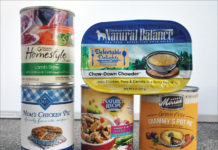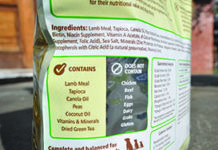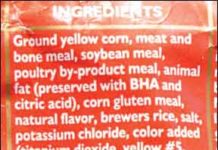About Dog Food Manufacturers and Co-Manufacturers
wholedogjournal_editorial
5 Steps To Determine How Much To Feed Your Dog
Each and every one of the six people who adopted the puppies I fostered recently asked me the same question: How much should I feed him?" I was surprised the first time
The Top 5 Things to Look for on a Commercial Dog Food Label
Recently I visited a fancy new pet supply store?* seriously, the fanciest store I've ever seen. It boasts a fenced and rubber-matted area for patrons' dogs to play while their owners shop; an area where owners can bathe their dogs (with warm water, cross ties in the raised tubs, shampoo and conditioner on tap, waterproof aprons, cool blow driers, and plenty of towels); an area where visiting veterinarians can provide vaccinations and basic health exams; a climate-controlled, glassed-in area for puppy and dog training classes; and, oh yeah, aisle after aisle after aisle of toys, beds, treats, shampoos, and lots and lots of dog (and cat) food.
Dog Food Logic – Make Smart Decisions on What You Feed Your Dog
The following is an excerpt adapted from a new book that can help you make smart decisions about what to feed your dog.
Whole Foods in Vet-Prescribed Dog Food
Three months ago, I asked, Why can't veterinary nutritionists design recipes that meet most nutritional needs through the use of whole foods
Humanization of Dog Food
Industry analysts frequently observe that “humanization” has been a hot trend in pet food for the past few years. The term is used to describe products containing ingredients that are popular in the human food industry, as well as those that are manufactured and/or packaged to resemble human food.
New Guides In Town
When buying food for their dogs, owners depend on the product manufacturers to deliver a “complete and balanced” diet in those bags, cans, and frozen packages. Perhaps without even being aware of it, owners also understand that there are government agencies responsible for setting standards as to what constitutes a “complete and balanced diet” for dogs, and for making sure that pet food makers meet those standards.
Choosing the Right Top-Quality Dog Food
premium / natural / holistic pet food makers.üToo many choices? Never! It's good to have options
The Dog Food Industry Has Come a Long Way!
the smart companies have found ways to offer products with the kind of ingredients that discerning pet owners want to see on the label. It's doubly smart
Finding the Truth on the Dog Food Label
Have you ever wondered whether the label information on your dog's food packaging is accurate? If so, welcome to the club! We fret about this sort of thing, too and sometimes, our worries turn out to be well-founded.
Dietary Fats in Dog Food
As soon as a food is manufactured, it begins to undergo a variety of chemical and physical changes. It's a basic law of the universe (the second law of thermodynamics) that everything degrades over time. This includes the proteins and vitamins in dog foods, but it's the fats I worry about the most.
Corn-Containing Dog Food at Increased Risk of Aflotoxin
Fungus is more than a nuisance when it comes to corn; it can be deadly to dogs (and humans). Actually, it’s not fungus itself that’s a problem; the peril is a secondary chemical product created by the metabolic process of certain fungal species, in particular, Aspergillus flavus and Aspergillus parasiticus. Aflatoxin, the chemical produced by these fungi is not just toxic, it’s one of the most carcinogenic substances known to science.


















